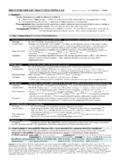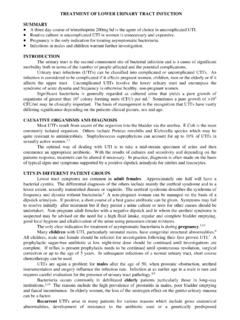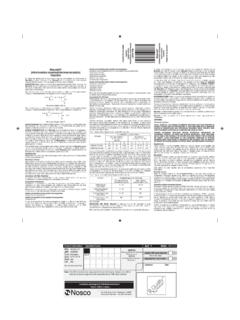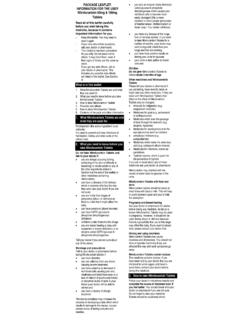Transcription of NEW ZEALAND DATA SHEET 1. NIFURAN TABLETS 50 MG …
1 NIFURAN 10 July 2017 1 of 10 NEW ZEALAND DATA SHEET 1. NIFURAN TABLETS 50 MG AND 100 MG 2. qualitative AND quantitative COMPOSITION Each tablet contains 50 mg or 100 mg nitrofurantoin . For full list of excipients, see section 3. PHARMACEUTICAL FORM Yellow scored TABLETS . 4. CLINICAL PARTICULARS Therapeutic indications nitrofurantoin is an antibacterial agent specific for urinary tract infections. nitrofurantoin is indicated for the prophylaxis and treatment of infections of the genito-urinary tract due to susceptible bacteria. Therapy with nitrofurantoin may be initiated before results of culture and susceptibility tests are known; therapy should be continued or altered, as appropriate, in accordance with results of the tests.
2 Dose and method of administration nitrofurantoin should be taken with food or milk. Acute, Uncomplicated Urinary Tract Infections (acute cystitis) Adults: Usual dose 50-100 mg four times daily for 7 days. Children under 12 years: 5-7 mg/kg body weight per 24 hours, given in four divided doses (NB contraindicated in neonates under one month of age). Prophylactic Therapy Adults: Usual dose 50-100 mg at bedtime. Children under 12 years: 1 mg/kg body weight per 24 hours, given in a single dose or in two divided doses (NB contraindicated in neonates under one month of age). See section Special warnings and precautions for use regarding risks associated with long-term therapy.
3 Note: duration of long-term prophylaxis is up to 6 months. Long-term therapy should be continued beyond 6 months only when the benefits clearly outweigh the risks. NIFURAN 10 July 2017 2 of 10 Paediatric population See dosage information above. Contraindications Anuria, oliguria, or significant impairment of renal function (creatinine clearance under 60 mL per minute or clinically significant elevated serum creatinine) are contraindications. Treatment of this type of patient carries an increased risk of toxicity because of impaired excretion of the medicine.
4 Because of the possibility of haemolytic anaemia due to immature erythrocyte enzyme systems (glutathione instability), the medicine is contraindicated in pregnant women during labour and delivery, or when the onset of labour is imminent. For the same reason, the medicine is contraindicated in neonates less than one month of age. nitrofurantoin is also contraindicated in those patients with known hypersensitivity to the medicine. Special warnings and precautions for use Warnings Acute, subacute, or chronic pulmonary reactions have been observed in patients treated with nitrofurantoin .
5 If these reactions occur, the medicine should be discontinued and appropriate measures taken. Reports have cited pulmonary reactions as a contributing cause of death. Chronic pulmonary reactions (diffuse interstitial pneumonitis or pulmonary fibrosis, or both) can develop insidiously. These reactions occur rarely and generally in patients receiving therapy for six months or longer. Close monitoring of the pulmonary condition of patients receiving long-term therapy is warranted and requires that the benefits of therapy be weighed against potential risks (see section Undesirable effects Respiratory.)
6 Hepatic reactions, including hepatitis, cholestatic jaundice, chronic active hepatitis, and hepatic necrosis, occur rarely. Fatalities have been reported. The onset of chronic active hepatitis may be insidious, and patients should be monitored periodically for changes in liver function. If hepatitis occurs, the medicine should be withdrawn immediately and appropriate measures should be taken. Peripheral neuropathy (including optic neuritis), which may become severe or irreversible, has occurred. Fatalities have been reported. Conditions such as renal impairment (creatinine clearance under 60 mL per minute or clinically significant elevated serum creatinine), anemia, diabetes mellitus, electrolyte imbalance, vitamin B deficiency, and debilitating disease may enhance the occurrence of peripheral neuropathy.
7 Patients receiving long-term therapy should be monitored periodically for changes in renal function. Cases of haemolytic anemia of the primaquine-sensitivity type have been induced by nitrofurantoin . Haemolysis appears to be linked to a glucose-6-phosphate dehydrogenase deficiency in the red blood cells of the affected patients. Haemolysis is an indication for discontinuing nitrofurantoin ; haemolysis ceases when the medicine is withdrawn. NIFURAN 10 July 2017 3 of 10 Precautions Patients should be advised to take nitrofurantoin with food to further enhance tolerance and improve its absorption.
8 Patients should be instructed to complete the full course of therapy; however, they should be advised to contact their physician if any unusual symptoms occur during therapy. Patients should be advised not to use antacid preparations containing magnesium trisilicate at the same time as nitrofurantoin because of the possibility of impaired absorption. The tendency of nitrofurantoin to impart a brown colour to the urine is of no clinical significance. Interaction with other medicines and other forms of interaction Antacids containing magnesium trisilicate, when administered concomitantly with nitrofurantoin , reduce both the rate and extent of absorption.
9 The mechanism for this interaction probably is adsorption of nitrofurantoin onto the surface of magnesium trisilicate. Uricosuric medicines, such as probenecid and sulphinpyrazone, can inhibit renal tubular secretion of nitrofurantoin . The resulting increase in nitrofurantoin serum levels may increase toxicity, and the decreased urinary levels could lessen its efficacy as a urinary tract antibacterial. Drug/Laboratory Test Interactions As a result of the presence of nitrofurantoin , a false-positive reaction for glucose in the urine may occur. This has been observed with Benedict's and Fehling's solutions but not with the glucose enzymatic test.
10 Antagonism has been demonstrated in vitro between nitrofurantoin and quinolone antimicrobials. The clinical significance of this finding is unknown. Fertility, pregnancy and lactation Fertility Teratogenic effects Several reproduction studies have been performed in rabbits and rats at doses up to six times the human dose and have revealed no evidence of impaired fertility or harm to the foetus due to nitrofurantoin . In a single published study conducted in mice at 68 times the human dose (based on mg/kg administered to the dam), growth retardation and a low incidence of minor and common malformations were observed.














